Superb Li-Ion Storage of Sn-Based Anode Assisted by Conductive Hybrid Buffering Matrix
Abstract
:1. Introduction
2. Materials and Methods
2.1. Synthesis of Sn-TiO2-C, Sn-TiO2, and Sn-C Composite
2.2. Cell Preparation
2.3. Characterization
2.4. Electrochemical Measurement
3. Results and Discussion
3.1. Characterization of As-Synthesized Sn-TiO2-C
3.2. Electrochemical Reaction Mechanism and Kinetics of Sn-TiO2-C Anode
3.3. Electrochemical Performance of Sn-TiO2-C Anode
4. Conclusions
Supplementary Materials
Author Contributions
Funding
Data Availability Statement
Conflicts of Interest
References
- Kim, S.; Park, K. Electrode design to mitigate the kinetic issue of cathodes in high energy lithium-ion batteries. J. Power Source 2022, 547, 231916. [Google Scholar] [CrossRef]
- Kim, S.; Na, S.; Kim, J.; Jun, T.H.; Oh, M.H.; Min, K.; Park, K. Multifunctional surface modification with Co-free spinel structure on Ni-rich cathode material for improved electrochemical performance. J. Alloys Compd. 2022, 918, 165454. [Google Scholar] [CrossRef]
- Cho, H.; Park, K. Mitigating the Kinetic Hindrance of the Poly/Single-Crystalline Ni-Rich Cathode-Based Electrode via Formation of the Superior Electronic/Ionic Pathway. ACS Appl. Energy Mater. 2022, 5, 11223–11228. [Google Scholar] [CrossRef]
- Na, S.; Park, K. Hybrid dual conductor on Ni-rich NCM for superior electrochemical performance in Lithium-ion batteries. Int. J. Energy Res. 2022, 46, 7389–7398. [Google Scholar] [CrossRef]
- Tran, M.X.; Nguyen, T.-A.; Lee, J.K.; Lee, S.-W. Porous silicon covalently-grafted with chloro-styrenic carbons for fast Li+ diffusion and durable lithium-storage capability. J. Power Source 2023, 554, 232326. [Google Scholar] [CrossRef]
- Tran, M.X.; Woo, J.-Y.; Nguyen, T.-A.; Lee, S.-W.; Lee, J.K. Thermolytically grafted silicon particles with ultrathin carbonaceous coating rich of phenyl moieties as lithium-storage anode material. J. Chem. Eng. 2020, 395, 125169. [Google Scholar] [CrossRef]
- Lim, Y.E.; Choi, W.S.; Kim, J.H.; Ahn, Y.N.; Kim, I.T. The Sn–red P–Fe–based alloy materials for efficient Li–ion battery anodes. J. Ind. Eng. Chem. 2023, 121, 299–311. [Google Scholar] [CrossRef]
- Lee, J.; Jung, W.S.; Lee, S.-W. N-doped ZnC composites with gelatin coating as enhanced lithium-storage anode materials. J. Mater. Sci. 2022, 57, 21996–22005. [Google Scholar] [CrossRef]
- Salunkhe, T.T.; Varma, R.S.; Kadam, A.N.; Lee, S.-W.; Lee, Y.-C.; Hur, J.; Kim, I.T. Scraps to superior anodes for Li-ion batteries: Sustainable and scalable upgrading of waste rust. J. Hazard. Mater. 2021, 410, 124571. [Google Scholar] [CrossRef]
- Nguyen, Q.H.; Phung, V.D.; Kidanu, W.G.; Ahn, Y.N.; Nguyen, T.L.; Kim, I.T. Carbon-free Cu/SbxOy/Sb nanocomposites with yolk-shell and hollow structures as high-performance anodes for lithium-ion storage. J. Alloys Compd. 2021, 878, 160447. [Google Scholar] [CrossRef]
- Lee, H.; Preman, A.N.; Vo, T.N.; Lee, J.-H.; Kim, I.T.; Ahn, S.-k. In situ crosslinkable acrylic random copolymer binders for silicon anodes in lithium-ion batteries. Int. J. Energy Res. 2022, 46, 12565–12578. [Google Scholar] [CrossRef]
- Inaba, M.; Uno, T.; Tasaka, A. Irreversible capacity of electrodeposited Sn thin film anode. J. Power Source 2005, 146, 473–477. [Google Scholar] [CrossRef]
- Sun, J.; Zheng, G.; Lee, H.-W.; Liu, N.; Wang, H.; Yao, H.; Yang, W.; Cui, Y. Formation of stable phosphorus–carbon bond for enhanced performance in black phosphorus nanoparticle–graphite composite battery anodes. Nano Lett. 2014, 14, 4573–4580. [Google Scholar] [CrossRef] [PubMed]
- Jin, Y.; Zhu, B.; Lu, Z.; Liu, N.; Zhu, J. Challenges and recent progress in the development of Si anodes for lithium-ion battery. Adv. Energy Mater. 2017, 7, 1700715. [Google Scholar] [CrossRef]
- Qin, J.; He, C.; Zhao, N.; Wang, Z.; Shi, C.; Liu, E.-Z.; Li, J. Graphene networks anchored with Sn@graphene as lithium ion battery anode. ACS Nano 2014, 8, 1728–1738. [Google Scholar] [CrossRef]
- Bogart, T.D.; Chockla, A.M.; Korgel, B.A. High capacity lithium ion battery anodes of silicon and germanium. Curr. Opin. Chem. Eng. 2013, 2, 286–293. [Google Scholar] [CrossRef]
- Idota, Y.; Kubota, T.; Matsufuji, A.; Maekawa, Y.; Miyasaka, T. Tin-based amorphous oxide: A high-capacity lithium-ion-storage material. Science 1997, 276, 1395–1397. [Google Scholar] [CrossRef]
- Dang, H.X.; Klavetter, K.C.; Meyerson, M.L.; Heller, A.; Mullins, C.B. Tin microparticles for a lithium ion battery anode with enhanced cycling stability and efficiency derived from Se-doping. J. Mater. Chem. A 2015, 3, 13500–13506. [Google Scholar] [CrossRef]
- Hassoun, J.; Derrien, G.; Panero, S.; Scrosati, B. A nanostructured Sn–C composite lithium battery electrode with unique stability and high electrochemical performance. Adv. Mater. 2008, 20, 3169–3175. [Google Scholar] [CrossRef]
- Fan, X.-Y.; Ke, F.-S.; Wei, G.-Z.; Huang, L.; Sun, S.-G. Sn–Co alloy anode using porous Cu as current collector for lithium ion battery. J. Alloys Compd. 2009, 476, 70–73. [Google Scholar] [CrossRef]
- Wu, M.; Wang, C.; Chen, J.; Wang, F.; Yi, B. Sn/carbon nanotube composite anode with improved cycle performance for lithium-ion battery. Ionics 2013, 19, 1341–1347. [Google Scholar] [CrossRef]
- Fang, L.; Chowdari, B. Sn–Ca amorphous alloy as anode for lithium ion battery. J. Power Source 2001, 97, 181–184. [Google Scholar] [CrossRef]
- Deng, Q.; Huang, Z.; Dai, X.; Wang, Y.; Li, Z.; Li, J. Three-dimensional nanoporous and nanopillar composite Cu-Sn electrode for lithium-ion battery. J. Solid State Electrochem. 2015, 19, 1765–1771. [Google Scholar] [CrossRef]
- Liu, W.; Gou, H.; Dong, X.; Zhang, S.; Shi, S. Rational design of PANI-modified three-dimensional dendritic hierarchical porous Cu–Sn nanocomposites as thick anodes with ultrahigh areal capacity and good cycling stability. Battery Energy 2023, 2, 20220032. [Google Scholar] [CrossRef]
- Yan, Y.; Liu, Y.; Zhang, Y.; Qin, C.; Yu, H.; Bakenov, Z.; Wang, Z. Sn modified nanoporous Ge for improved lithium storage performance. J. Colloid Interface Sci. 2021, 602, 563–572. [Google Scholar] [CrossRef]
- Zhao, J.-G.; Zhou, H.-Y.; Hu, Z.; Wu, Y.-W.; Jia, H.; Liu, X.-M. Sn-MOFs/G composite materials for long cycling performance lithium ion batteries. Rare Met. 2022, 41, 1504–1511. [Google Scholar] [CrossRef]
- Lu, M.; Tian, Y.; Li, Y.; Li, W.; Zheng, X.; Huang, B. Synthesis and characterization of spherical-like tin-nickel alloy as anode for lithium ion batteries. Int. J. Electrochem. Sci. 2012, 7, 760–767. [Google Scholar] [CrossRef]
- Hassoun, J.; Derrien, G.; Panero, S.; Scrosati, B. A SnSb–C nanocomposite as high performance electrode for lithium ion batteries. Electrochim. Acta 2009, 54, 4441–4444. [Google Scholar] [CrossRef]
- Youn, D.H.; Stauffer, S.K.; Xiao, P.; Park, H.; Nam, Y.; Dolocan, A.; Henkelman, G.; Heller, A.; Mullins, C.B. Simple synthesis of nanocrystalline tin sulfide/N-doped reduced graphene oxide composites as lithium ion battery anodes. ACS Nano 2016, 10, 10778–10788. [Google Scholar] [CrossRef]
- Kim, S.-O.; Manthiram, A. High-performance Zn–TiC–C nanocomposite alloy anode with exceptional cycle life for lithium-ion batteries. ACS Appl. Mater. Interfaces 2015, 7, 14801–14807. [Google Scholar] [CrossRef]
- Kim, W.S.; Vo, T.N.; Kim, I.T. GeTe-TiC-C composite anodes for li-ion storage. Materials 2020, 13, 4222. [Google Scholar] [CrossRef] [PubMed]
- Kim, I.T.; Allcorn, E.; Manthiram, A. Cu6Sn5–TiC–C nanocomposite anodes for high-performance sodium-ion batteries. J. Power Source 2015, 281, 11–17. [Google Scholar] [CrossRef]
- Wang, X.; Cao, B.; Gao, Q.; Cao, Q.; Hu, P.; Zhang, Y.; Wei, W.; Wang, H. Highly conductive MXene binder enabling Ge anode for stable sodium storage. Appl. Phys. Lett. 2022, 121, 153902. [Google Scholar] [CrossRef]
- Gong, L.; Yao, C.; Chen, Z.; Sun, X.; Wang, H.; Gong, F. Construction of carbon net supported heterostructure with enhanced mesoscale diffusion for hydrogen production. Mater. Lett. 2023, 353, 135294. [Google Scholar] [CrossRef]
- Liang, L.; Tang, M.; Zhu, Q.; Wei, W.; Wang, S.; Wang, J.; Chen, J.; Yu, D.; Wang, H. Chemical Prepotassiation Realizes Scalable KC8 Foil Anodes for Potassium-Ion Pouch Cells. Adv. Energy Mater. 2023, 13, 2300453. [Google Scholar] [CrossRef]
- Xu, W.; Kong, L.; Huang, H.; Zhong, M.; Liu, Y.; Bu, X.-H. Sn nanocrystals embedded in porous TiO2/C with improved capacity for sodium-ion batteries. Inorg. Chem. Front. 2019, 6, 2675–2681. [Google Scholar] [CrossRef]
- Zhang, S.; Xing, Y.; Jiang, T.; Du, Z.; Li, F.; He, L.; Liu, W. A three-dimensional tin-coated nanoporous copper for lithium-ion battery anodes. J. Power Source 2011, 196, 6915–6919. [Google Scholar] [CrossRef]
- Luo, B.; Qiu, T.; Ye, D.; Wang, L.; Zhi, L. Tin nanoparticles encapsulated in graphene backboned carbonaceous foams as high-performance anodes for lithium-ion and sodium-ion storage. Nano Energy 2016, 22, 232–240. [Google Scholar] [CrossRef]
- Liu, K.; Wang, J.-A.; Zheng, H.; Guo, S.; Wang, X.; Man, J.; Wang, X.; Sun, J. A sustainable strategy for fabricating porous carbon supported Sn submicron spheres by self-generated Na2CO3 as templates for lithium-ion battery anode. Green Chem. 2021, 23, 6490–6500. [Google Scholar] [CrossRef]
- Park, J.-W.; Park, C.-M. A Fundamental Understanding of Li Insertion/Extraction Behaviors in SnO and SnO2. J. Electrochem. Soc. 2015, 162, A2811–A2816. [Google Scholar] [CrossRef]
- Lee, J.H.; Oh, S.H.; Jeong, S.Y.; Kang, Y.C.; Cho, J.S. Rattle-type porous Sn/C composite fibers with uniformly distributed nanovoids containing metallic Sn nanoparticles for high-performance anode materials in lithium-ion batteries. Nanoscale 2018, 10, 21483–21491. [Google Scholar] [CrossRef] [PubMed]
- Tang, K.; Yu, X.; Sun, J.; Li, H.; Huang, X. Kinetic analysis on LiFePO4 thin films by CV, GITT, and EIS. Electrochim. Acta 2011, 56, 4869–4875. [Google Scholar] [CrossRef]
- Wang, H.; Wang, C.; Li, C.; Sun, Q. Wrinkled carbon-coated NiCo2O4 nanoclusters constructed by self-encapsulation of cellulose nanonetwork for lithium-ion batteries. ACS Sustain. Chem. Eng. 2019, 7, 10840–10846. [Google Scholar] [CrossRef]
- Zhang, Y.; Qi, Y.; Yin, Z.; Wang, H.; He, B.; Liang, X.; Li, J.; Li, Z. Nano-V2O5/Ti porous membrane electrode with enhanced electrochemical activity for the high-efficiency oxidation of cyclohexane. Green Chem. 2018, 20, 3944–3953. [Google Scholar] [CrossRef]
- Liao, Q.; Mu, M.; Zhao, S.; Zhang, L.; Jiang, T.; Ye, J.; Shen, X.; Zhou, G. Performance assessment and classification of retired lithium ion battery from electric vehicles for energy storage. Int. J. Hydrogen Energy 2017, 42, 18817–18823. [Google Scholar] [CrossRef]
- Ge, P.; Hou, H.; Banks, C.E.; Foster, C.W.; Li, S.; Zhang, Y.; He, J.; Zhang, C.; Ji, X. Binding MoSe2 with carbon constrained in carbonous nanosphere towards high-capacity and ultrafast Li/Na-ion storage. Energy Stor. Mater. 2018, 12, 310–323. [Google Scholar] [CrossRef]

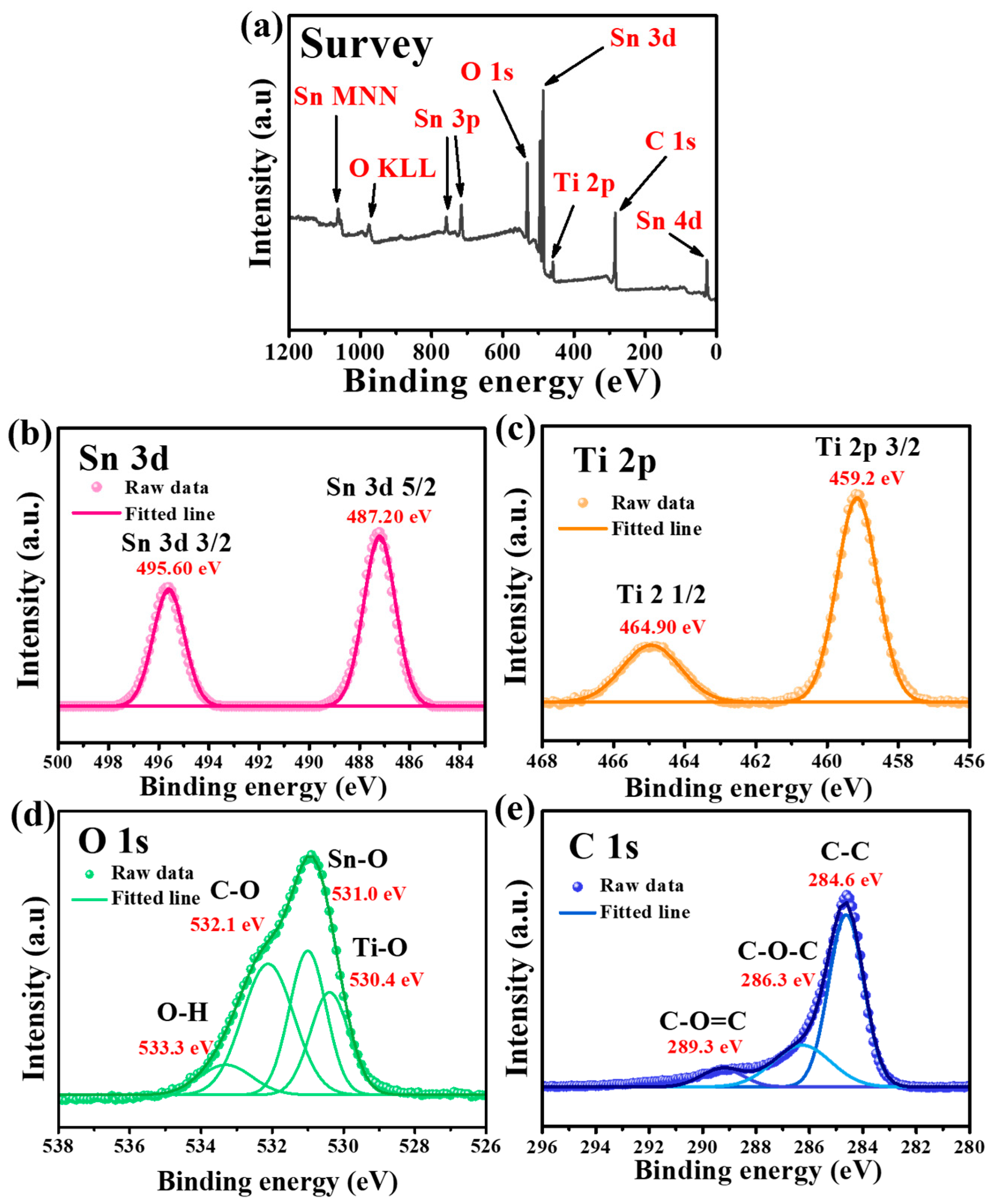
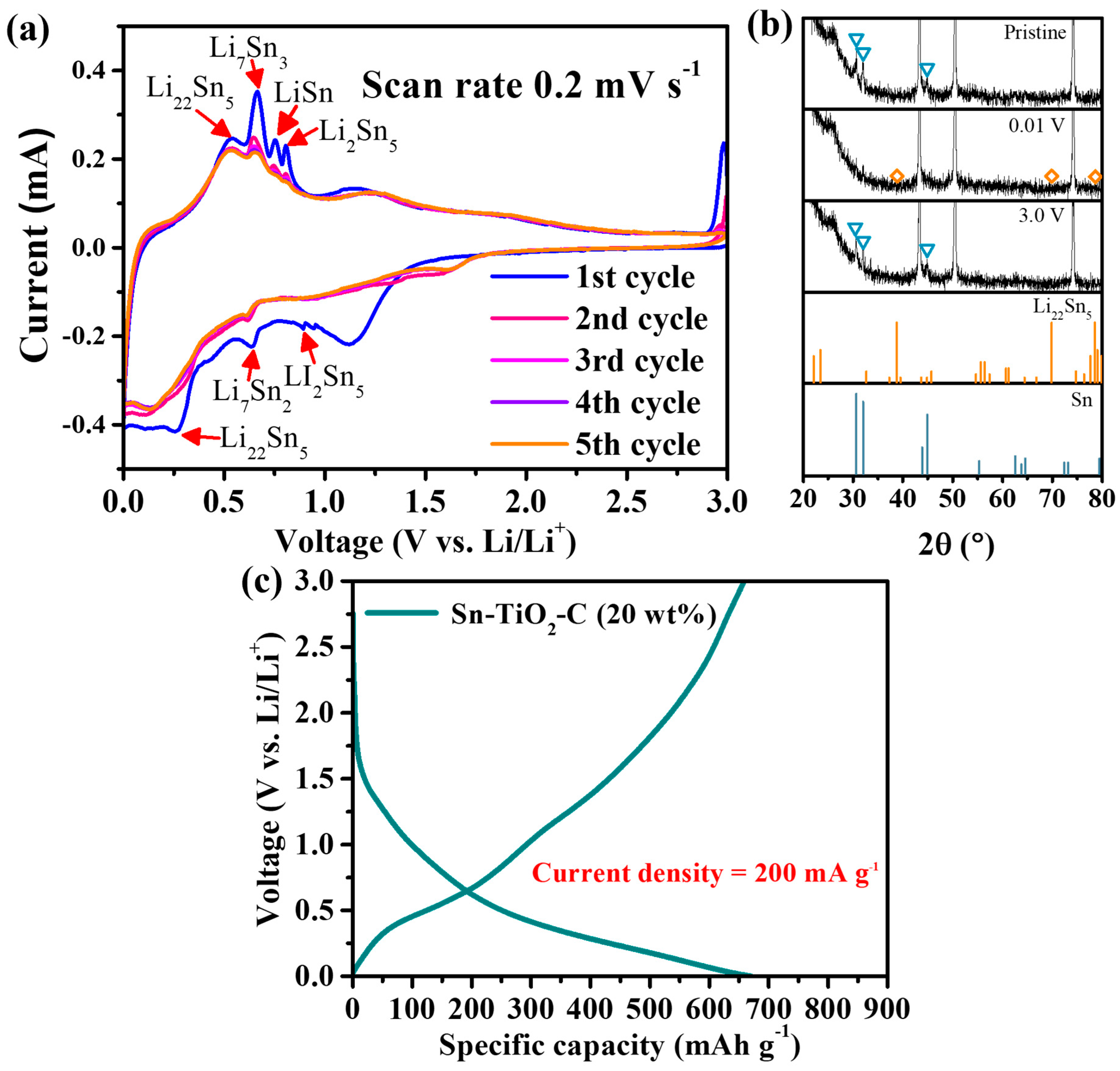
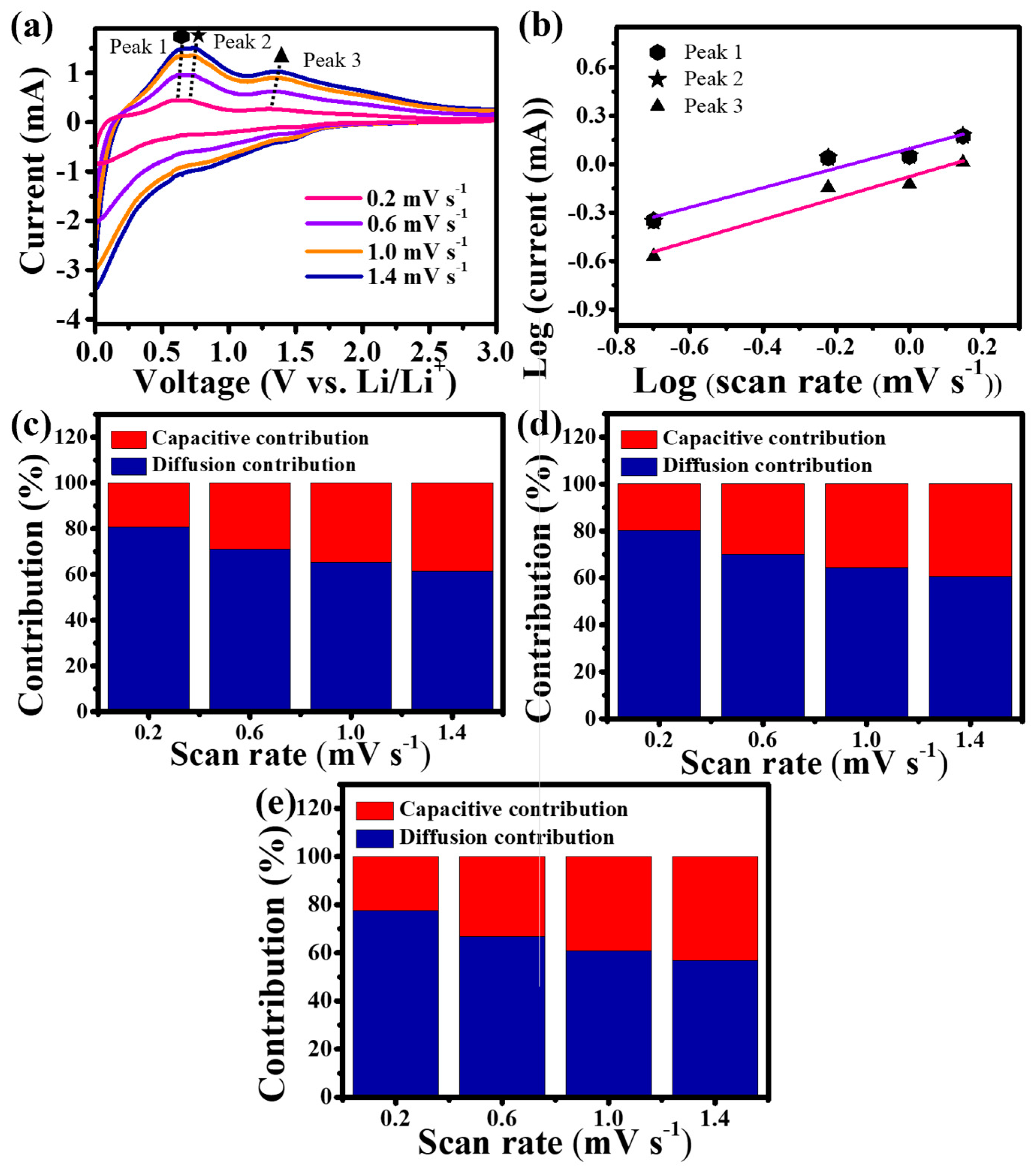
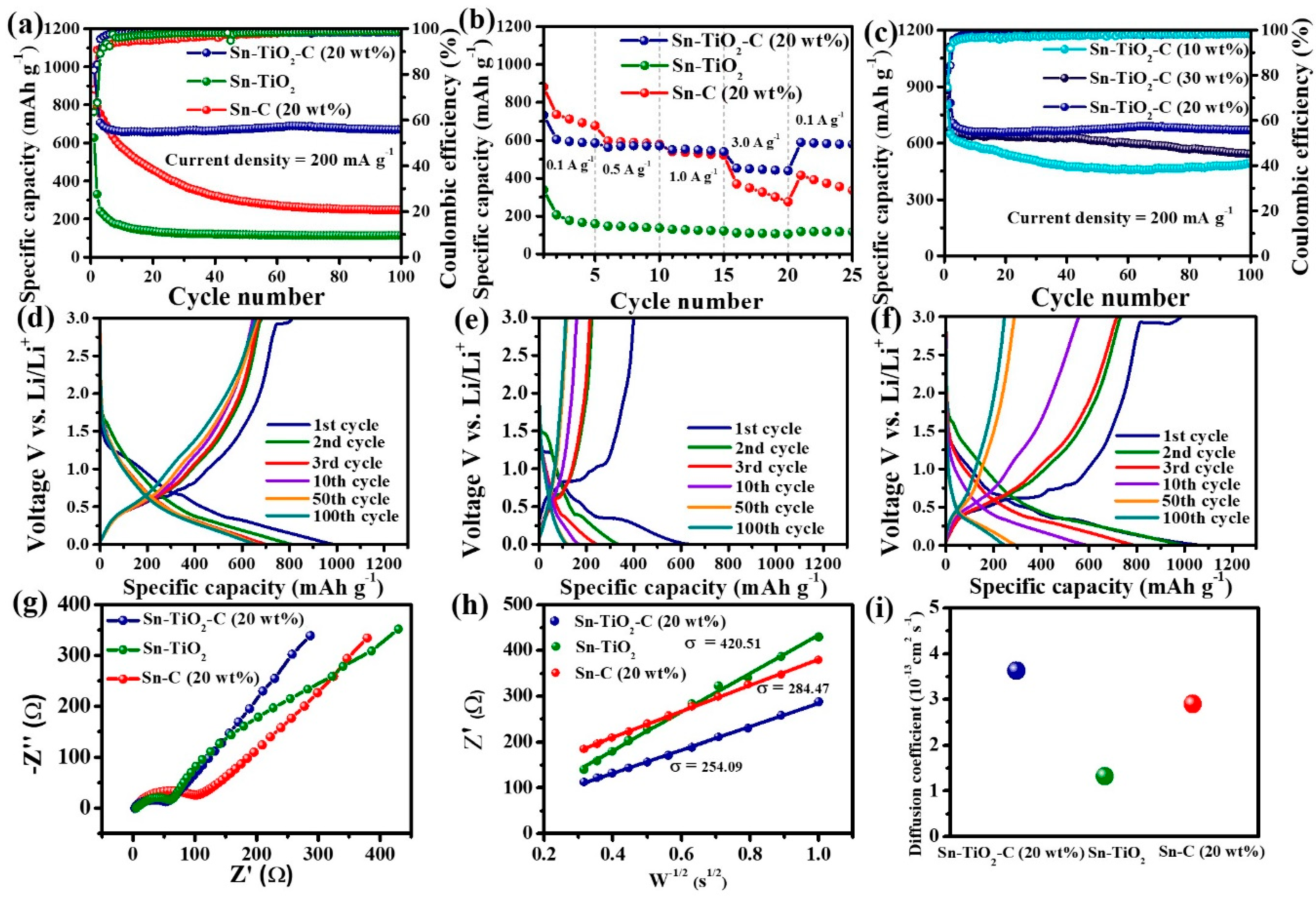
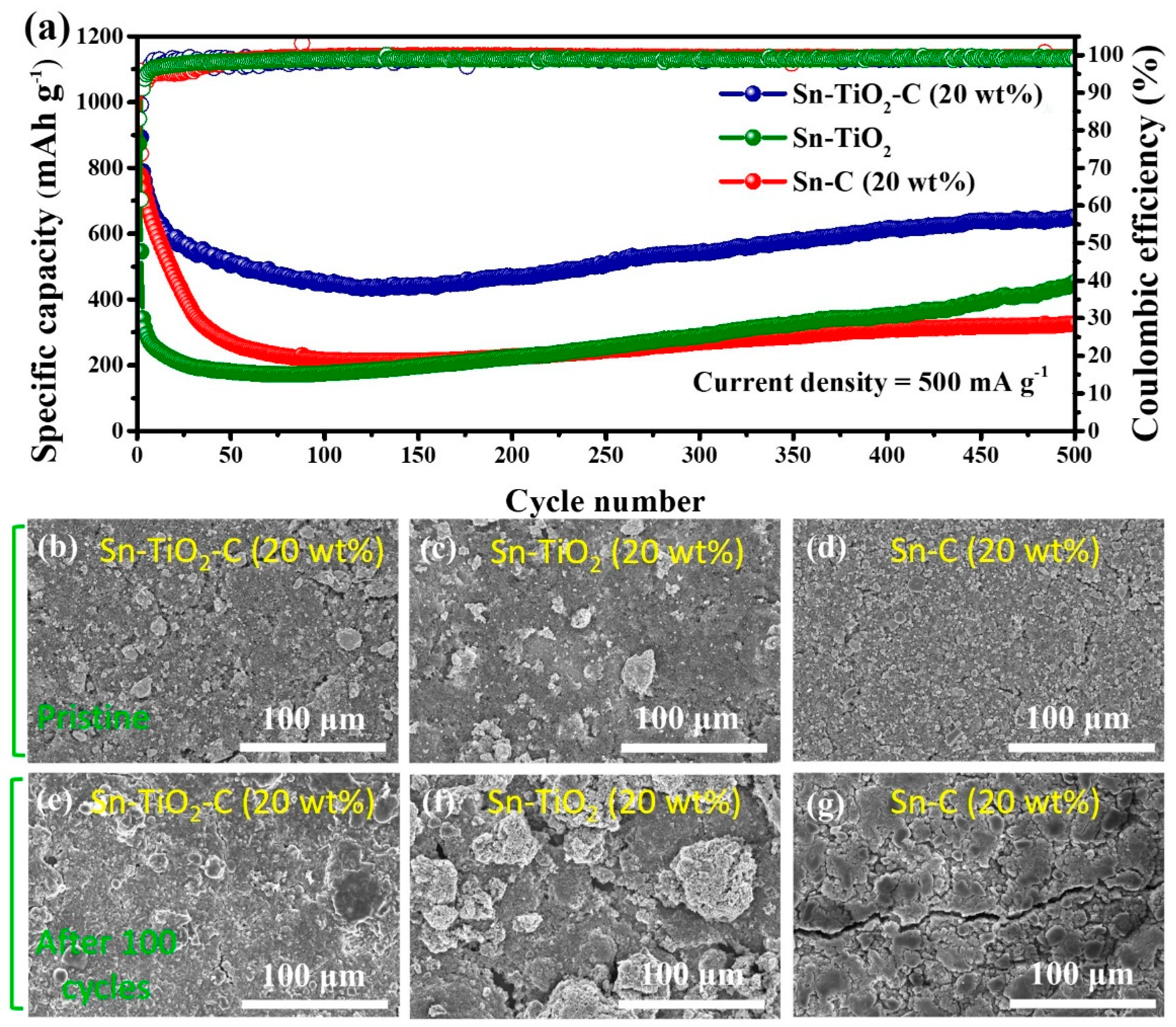
Disclaimer/Publisher’s Note: The statements, opinions and data contained in all publications are solely those of the individual author(s) and contributor(s) and not of MDPI and/or the editor(s). MDPI and/or the editor(s) disclaim responsibility for any injury to people or property resulting from any ideas, methods, instructions or products referred to in the content. |
© 2023 by the authors. Licensee MDPI, Basel, Switzerland. This article is an open access article distributed under the terms and conditions of the Creative Commons Attribution (CC BY) license (https://creativecommons.org/licenses/by/4.0/).
Share and Cite
Shin, J.; Park, S.-H.; Hur, J. Superb Li-Ion Storage of Sn-Based Anode Assisted by Conductive Hybrid Buffering Matrix. Nanomaterials 2023, 13, 2757. https://doi.org/10.3390/nano13202757
Shin J, Park S-H, Hur J. Superb Li-Ion Storage of Sn-Based Anode Assisted by Conductive Hybrid Buffering Matrix. Nanomaterials. 2023; 13(20):2757. https://doi.org/10.3390/nano13202757
Chicago/Turabian StyleShin, Jinsil, Sung-Hoon Park, and Jaehyun Hur. 2023. "Superb Li-Ion Storage of Sn-Based Anode Assisted by Conductive Hybrid Buffering Matrix" Nanomaterials 13, no. 20: 2757. https://doi.org/10.3390/nano13202757




